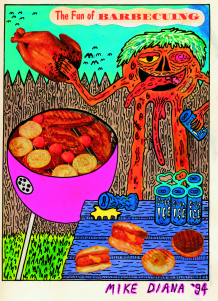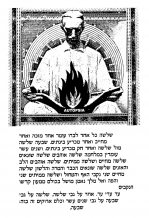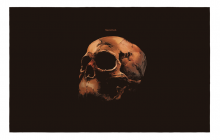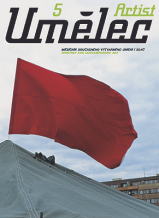| Umělec 2005/2 >> Hope-Stop! | Просмотр всех номеров | ||||||||||||
|
|||||||||||||
Hope-Stop!Umělec 2005/201.02.2005 Alena Boika | Moscow Biennale | en cs de |
|||||||||||||
|
On January 26, when the press-conference of the First Moscow Biennale was at its height, an exhibition called Hope-Stop! opened at the Anatoly Zverev Center of Contemporary Art in Moscow. Its promoters called it an anti-Biennale.
Moscow-based art critic Andrey Kovalev asked the exhibition’s participants a simple question: "It is rumored that Hope-Stop! is an anti-Biennale. Is it true or not?" Here are some of the responses: Alexey Penzin: ”I would apply Fredric Jameson's definition of ideology as a strategy of limitation. This definition has a literal meaning with the biennale. As far as I know, some topics just cannot be represented within its framework. I think that it would be amusing in both the negative and positive sense of the word if Hope-Stop! artists were to represent a monstrous bloodcurdling mix of works on such subjects as Putin, Chechnya, and the Russian Orthodox Church. But is the passive and autistic ignoring presented by the other project, Russia-2, an alternative? Both variants might imply merely a negative or indirect dependence on the ideological framework of the Biennale that was established by a more extensive and very well-known political context. It is significant that the word "alternative" is mainly used now in the media. Those who use it operate on a binary logic that engenders rather abstract and empty contrasts. Indeed, what possible alternative could there be to the Biennale? If the Biennale is an ideological instance of selective representation, then any real alternative should be a complete absence of representation, an extra-parliamentary partisan war for means of art production.” Anatoly Osmolovsky: ”While the shiny and glossy celebrate imaginary victory, Hope-Stop! offers a more complex opinion about the state of affairs in Russian art. I am personally utterly concerned about moral and ethical issues associated with the organization of the First Moscow Biennale.” Stas Shuripa: ”The Moscow Biennale employs the language of economists in its announcement of a ‘Privatization of Hope’ (See www.moscowbiennale.ru). Through market terminology, it seeks to reduce the art process to a cultural industry. Hope-Stop! poses a question about the limits of a ‘prescribed and unalterable social system of capitalism’ (ibid), which, to my mind, is an attempt to enlarge the viewpoint.” Alexander Sokolov (project curator): ”To my mind, this exhibition can rather be considered complimentary with respect to the Biennale. The video by Anna Ermolaeva (St. Petersburg – Vienna) called Ass Peeping appears as a particular assessment of the Biennale’s name Dialectics of Hope. The Biennale website says, "The need for hope emerges as an after-effect of a lost feeling of safety and impossibility to entirely rely on anybody or anything." The continuation of the saying is in the spirit of ‘religion, opium for the people...the ability to hope allows the examination of a private and collective future with optimism…’" Stickers Diverse art events and discussion took place within the framework of the exhibition. An action called Stickers was particularly noticeable. These were 34 x 45 mm stickers presented as an alternative to common mass media communication by compensating for the sundry filters generally applied. Stickers were distributed among all the visitors to the Zverev center on January 26. During the official opening of the Biennale the next day, they were enthusiastically affixed wherever all major expositions were located: the Lenin Museum, the Shchusev Architectural Museum, and the Vorobiovy Gory metro station. Motley images were stuck both on walls and exhibited artifacts—the artworks of official Biennale participants. Amusing as it seems, some artists participated in both biennales. For example, Dmitry Gutov was exhibited in Marat Gelman's gallery at both Russia-2 and the Zverev Center. In his reply to Dmitry Vilensky, editor of the St. Petersburg newspaper What's to Be Done?, who indignantly asked how Gutov could participate in the official Biennale and give up ethics and morals, Gutov retorted coldly, "First of all, I am an artist. And I will participate in absolutely all art projects, in which I am invited to participate." On January 31, a discussion on the issue of What's to Be Done? entitled State of Emergency took place. Artists, philosophers and leftist critics of contemporary Russia who participated included Dmitry Vilensky, Boris Kagarlitsky, Alexey Penzin, and David Riff. They expressed concern over the changes in political Russian, which undoubtedly is reflected in the social and cultural spheres. After recent developments in both Russia and the Commonwealth of Independent States (CIS) countries, the sense of a gap—a "failure to return" in contrast to that order, which was there not long ago—has become increasingly evident. The events in Ukraine served as a clear reminder that the old Empire and the cold war are still alive and continue to have a decisive impact on perceptions and interpretations of current events. It is obvious that these political processes will be reflected in cultural politics too. Independent critical opinion in Russia (and everywhere) is under constant pressure from market forces and realpolitik demanding populist legitimization of policies from "masters of culture," In contemporary circumstances we often see that these demands are interrelated. Of about 20 people who took part in the discussion, seven participated actively. Can such a small group of Russian intellectuals influence the course of an Empire’s machine? I would like to believe that historical experience again proves true. On February 5, the exhibition hosted the presentation of a book A Big Project for Russia. Conference Materials, a volume issued by the Art Magazine together with the Zverev Center of Contemporary Art), was based on strategic advice offered by leading world curators regarding the organization of the Moscow Biennale at the conference in Moscow in December 2003. Victor Miziano, the most famous of Russian curators, who was later pulled from the curatorial group as a result of intrigues, assisted in preparation with Anatoly Osmolovsky, Dmitry Gutov, Oxana Sarkisyan, Evgeny Chubarov, and Alexander Panov. In addition, artists participating from the Biennale included Alexey Kallima and Irina Korina. As expected, the discussion at the presentation exceeded the confines of the conference issues. The participants concluded that the main project had failed to become an effective performance or come across as an intellectual event. As Miziano said, "For bureaucracy it is important that the Biennale took place. Its quality is secondary because the task of the creation of art under state control has been accomplished." In general, the discussion could be summarized as a lively conversation featuring frequent use of philosophical phrases derived from the word "prick." The artistic aspect of Hope-Stop! was true to form as an anti-biennale. Indeed, it was well-built and directed according to a coherent curatorial concept, in contrast to the official Biennale. Moreover, it was assembled in a single exhibition, at the Zverev Center; at the main Moscow Biennale, there were so much information describing main, special and parallel programs, that it was impossible to avoid confusion. In addition, dates and times of openings could be adjusted arbitrarily and on short notice. And third, the Hope-Stop! art works were deliberately inartistic. Most were conceptual works prompting thought and substituting eye-candy with the ascetic abstinence of militant dissent. A Swastika Made of Boots, Installation by Pavel Peppershtein. 2004 ”…He walked through a southern town. It was crowded like a bazaar. People were yelling something in an unknown language. Kursky had never been in a Central Asian town before. It could be Tashkent or Samarqand or maybe Kabul or Cyprus. Low old houses built in the colonial style surrounded him. He walked along a hot dirty road barefoot with boots in his hands. It seemed silly: he might encounter broken glass, food scraps, garbage, or venomous insects. He stopped and put the boots on. It was much more comfortable. But before he could travel far, he found himself barefoot with the boots in his hands again. Evidently he had begun thinking about something, and accidentally took off his boots. He had to stop and put the boots on again. He continued to walk, squinting in the bright sunlight, but it happened again: he again was barefoot with the boots in his hands. He put the boots back on. The walk seemed interesting and the town amused. But again, one look aside and he was again walking barefoot on the dangerous road and his hands grasped the boots tightly. Then he decided to get rid of the boots. He drew his arm back and threw the boots into the open doorway of some tumbledown house. They fell on the steps of a wooden staircase leading to the first floor. The dreamer wanted to continue his way through the town but couldn’t. The sight of two black, narrow-toed, polished boots lying on the cracked, dusty steps captivated him. He stood there not daring to turn away. There was something painful and pathetic in their misplaced elegance, their helplessness, their humbleness lying on the steps. Pathetic, but significant—almost religious. No, he could not leave them lying in the foreign and rough town. He entered the doorway and warily ascended the old timber steps, running the risk of getting a splinter or stepping on a rusty nail, and he again took the boots into his hands. A moment of anger seized him as he understood that the boots were drawing him into an abyss of ravings, all hot, dusty, and gnarled just as this town. As hard as he could, he hurled the boots up to the top step of the staircase; they landed there with a resigned thud, thoughtfully obeying the will of their master. He felt sorry for them as they lay there like two little black crocodiles staring at him with their eyelet-holes. He approached them, picked them up, and immediately cast them away. They fell on the floor in some dark corridor. Again he pitied them. Finally, he understood that the boots were somehow guiding him somewhere. He found himself in a hallway with several high and dilapidated doors. He began to open the doors and peer inside: the rooms were all empty and old, the sunshine and southern town noise seeped through dusty windows. But there were signs of life in those rooms. Many boots stood on the floor in each one. Many pairs, which formed signs. In the first room, boots were set out in the form of a large cross. Worn but well-polished and standing close together in pairs, there were men’s boots, women’s shoes, children’s sandals, and even slippers. In the second room, a five-pointed star was made of boots. In the third, boots constituted the star of David. He opened the door a crack to the fifth room where there was a crescent created with boots. All of the signs were strictly symmetrical. As would be expected, the swastika was in room number four. As with the other signs it was made of boots, but one point remained incomplete. One pair was lacking for strict symmetry of the sign. Kursky solicitously placed his boots to complete the unfinished corner of the swastika to make it perfect. Apparently, the boots had aspired to get here from the very beginning, and this is why they had behaved so strangely. Kursky wanted to leave silently but glanced back and saw that the boots were still gazing at him with loving care. He returned, slipped his feet into the boots without moving them from the location that they occupied in the swastika composition. He stood motionlessly at the tip of one of the swastika's arms and showed no inclination to move any more. He knew that from then on and forever he would stand motionlessly in this old room knowing neither tiredness, boredom, nor death. The author referred to the materials available on the www.artinfo.ru website, the exhibition catalog, and her own participation in the aforementioned events.
01.02.2005
Рекомендуемые статьи
|
|||||||||||||
|
04.02.2020 10:17
Letošní 50. ročník Art Basel přilákal celkem 93 000 návštěvníků a sběratelů z 80 zemí světa. 290 prémiových galerií představilo umělecká díla od počátku 20. století až po současnost. Hlavní sektor přehlídky, tradičně v prvním patře výstavního prostoru, představil 232 předních galerií z celého světa nabízející umění nejvyšší kvality. Veletrh ukázal vzestupný trend prodeje prostřednictvím galerií jak soukromým sbírkám, tak i institucím. Kromě hlavního veletrhu stály za návštěvu i ty přidružené: Volta, Liste a Photo Basel, k tomu doprovodné programy a výstavy v místních institucích, které kvalitou daleko přesahují hranice města tj. Kunsthalle Basel, Kunstmuseum, Tinguely muzeum nebo Fondation Beyeler.
|



































 We Are Rising National Gallery For You! Go to Kyjov by Krásná Lípa no.37.
We Are Rising National Gallery For You! Go to Kyjov by Krásná Lípa no.37.
Комментарии
Статья не была прокомментированаДобавить новый комментарий